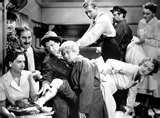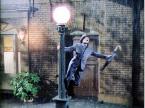It’s been a while since I’ve written about a mystery (or anything, I know). But this last weekend, I saw what I may very well call one of the greatest mystery films ever made. To tell the truth, there were only a handful of pre-1950s mystery/film-noir movies I had seen before this one; and, with the exception of Citizen Kane and a few others, all of them had been made by Alfred Hitchcock. And although I can’t get enough of Hitch, I thought it might be nice to try out some other mysteries.
Normally, I enjoy ’40s mystery/film-noir films and films with political thriller overtones, such as The Maltese Falcon (1941) or Foreign Correspondent (1941), but I rarely have the urge to watch them multiple times. There are certainly some standout films from this genre, like the ones mentioned above (and Sabotage (1936) and Secret Agent (1936) with Sir John Gielgud), but, at the risk of sounding very rude, there are many that don’t seem very great at all. Good, certainly, and most of them better than what comes out regularly these days. But nothing too terribly special. The Third Man is not that way. It is incredibly watchable. It’s not hackneyed or cliched, not very dated at all. Following are some of the reasons this movie is truly enjoyable.
The actors. The performances in this film are spectacular.
I’ve always liked Joseph Cotten. He seems to me like a somewhat tougher, more callous Joel McCrea. In The Third Man, he plays a moderately alcoholic writer of run-of-the-mill Western novels, and he plays it to perfection. He is suspicious, uneasy, sarcastic, vulnerable.
Then comes the beautiful, exotic, mysterious Alida Valli who plays Anna Schmidt. With a career that spanned nearly 70 years, this woman knew what she was doing. She brings all of the elegance and class she possessed to this role, making a memorable movie human and beautiful.
Trevor Howard, who, rather than being a popular leading man, mainly made his way in movie history as a supporting actor. In The Third Man, he plays Major Calloway, a man of business and of principle. In his job, he must not have emotion or personal involvement; he must be stoic and unshakable, yet understanding and efficient. That’s precisely how Howard plays it.
But the most important actor, perhaps, of this film is one of the greatest geniuses of cinema history: Orson Welles. His character, like Welles himself, is an utter enigma, without certainty or explanation. Without Orson playing this part, the film would perhaps not be a mystery.
The direction. This will be very short, because I’m at a loss for words. Very dynamic, innovative direction by Mr. Reed. He has done an untouchable job. Mystery-movie-makers take note.
The music. Oh, the music. This film boasts what is, in my opinion, the best score EVER in a motion picture. I’d say it’s even better than the score of Chaplin’s Limelight (1950), my other favorite.
It’s odd, certainly, and it seems unfitting to some. But, in my opinion, it’s eerie, brisk, full of mystery, and it reflects the story and the complex emotions of the characters with perfection.
On what is it played? you may ask. Anton Karas played the film’s remarkable theme on a fairly rare (as in, not heard too often nowadays; just making sure Harper understands the context) string instrument called a zither. To me, it’s beyond words. You just have to hear it for yourself. Sorry I couldn’t be more poetic.
The end scene. I judge the greatness of end scenes by their ability to leave me silent in thought, confusion, or shock for at least a minute after the film ends. Some of my favorite end scenes include those of Dr. Strangelove: How I Learned to Stop Worrying and Love the Bomb (1964), Last Year at Marienbad (1961), and The Third Man. The end of Dr. Strangelove caught me off-guard and left me shocked that anyone would dare to end a movie that way. Last Year at Marienbad’s ending, like the rest of the film, confused me more than any other movie ever has. The ending of The Third Man, with the silence of its protagonists, the moving zither music, the emotion… It left me silent. Pondering. Reflecting. Comprehending.
(A Very Brief) Synopsis
(CONTAINS MODERATE SPOILERS)
An American writer of pulp fiction named Holly Martins (Joseph Cotten) travels to post-war Vienna to visit an old friend, Harry Lime, only to find that Lime has mysteriously died. After some digging, Martins meets his deceased friend’s intimate, Anna Schmidt (Alida Valli). Together, they begin to investigate what really happened to Harry Lime.
Information
Directed by Carol Reed;
Written by Graham Greene (screenplay), Alexander Korda (story, uncredited), Carol Reed (uncredited), and Orson Welles (uncredited);
Starring Joseph Cotten as Holly Martins, Alida Valli as Anna Schmidt, Orson Welles as Harry Lime, and Trevor Howard as Major Calloway;
Produced by Hugh Perceval (associate producer), Carol Reed (producer), Alexander Korda (producer, uncredited), David O. Selznick (producer, uncredited);
Music by Anton Karas.
(Because of copyright issues, the Criterion Collection DVD of this film is now, sadly, out of print. However, as of now, it is available in its entirety for free on YouTube. Watch it there while it lasts. Everyone should be able to see this incredible piece of filmmaking.)
-luke




